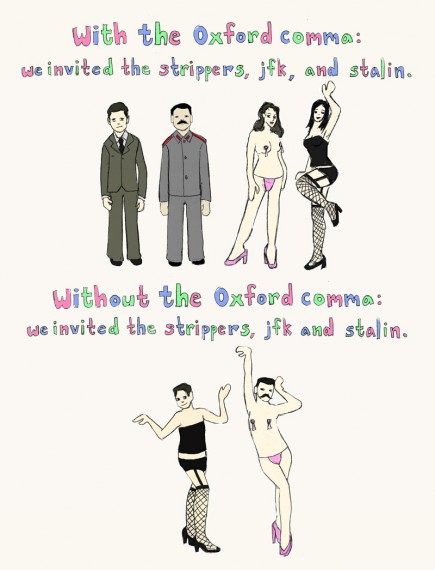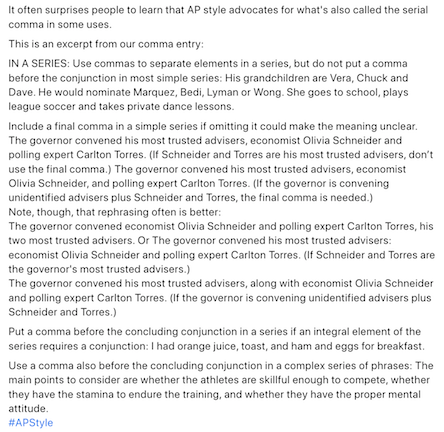You know the cartoon I’m talking about:

It’s a cute cartoon, but a good writer would never construct a sentence like “We invited the strippers, JFK and Stalin.”
Why not? Because accurate writing requires parallel structure.
Here are some examples of parallel structure:
“We invited Cinnamon, Krystal, JFK and Stalin”
“We invited the strippers and the politicians.”
Both sentences relay that two or more politicians and two more more strippers have been invited.
A non-parallel structure such as “We invited the strippers, JFK and Stalin” is constructed to obscure the fact that there are at least two politicians and at least two strippers involved—four invitees at minimum.
Of course, if the writer truly means that Stalin and JFK are strippers—and that they are the only two invitees—this sentence is perfectly fine.
Who Gives A Fuck About An Oxford Comma?
But the “joke” in the original cartoon is that Stalin and JFK aren’t really strippers.
So why is the serial comma—the “Oxford” comma—not necessary?
Put down your pitchforks, open your minds and buckle up …
A comma indicates where the reader should pause when reading a text. A comma also serves to replace the word “and” (or “or”) in serial constructions. As such, the following mean the same:
“Cinnamon and Krystal and JFK and Stalin”
“Cinnamon, Krystal, JFK, Stalin”
The “and” serves the same purpose as the comma, so the “and” in a non-Oxford construction is offset the final item in a series:
“Cinnamon, Krystal, JFK and Stalin”
Using the unnecessary “Oxford” comma, therefore, is the same as repeating the “and” unnecessarily:
“Cinnamon and Krystal and JFK and and Stalin”
The lesson? Cute cartoon. But a weak argument for an unnecessary bit of unnecessary punctuation.
The A.P. Stylebook Gets It Right
My high school and college journalism classes gave me a healthy appreciation for concise, clear and effective writing, and the The Associated Press Stylebook is a great guide for comma usage and everything else usage.
But Lynne Margolis, the Austin-based journo whose work I’ve followed for years, also had this to add about the Oxford Comma.

In other words, yes, there are always exceptions to the rule, and you should include the (normally) unneeded “Oxford” comma “if omitting it could make the meaning unclear”
Final Word On The Oxford Comma
A comma (among other functions) serves to take the place of a conjunction—in some cases the word “and.”
Using a comma AND the conjunction is saying “You have item one, item two and and item three.”
In other words, it’s wrong.
That Stalin and the strippers joke is just silly. A good writer would simply change the order of the series.
Leave a Reply